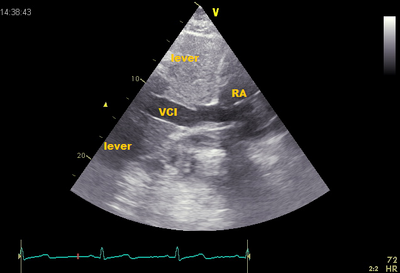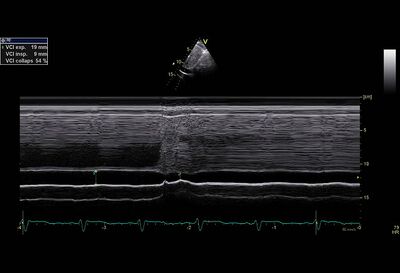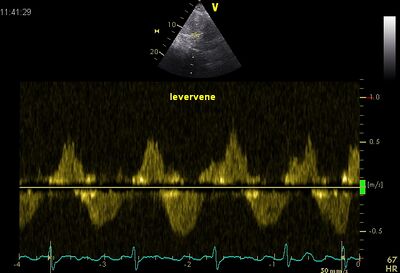Venae Cavae
Inferior vena cava
The inferior vena cava is the body's largest artery, which allows for the return flow of blood to the heart. This vein contains deoxygenated blood returning from the tissue in the lower part of the body (systemic circulation). The inferior vena cava subcostal is good to visualize. The VCI can be constricted by space-occupying processes, it is also called the VCI Syndrome.
| normal | borderline | dilated |
|---|---|---|
| <15mm | 15 - 20mm | >20mm |
Respiratory failure
In a normal RA pressure collapses the VCI in 80% of the cases, >40% (measured at the mouth of the hepatic vein). ±40% collapse VCI corresponds to a pressure of 8-10mmHg. At a collapse of 60-70%, the pressure in the VCI most often 2-4mmHg. At a collapse <40%, the VCI pressure >10mmHg (85%). When dilated, not collapsing VCI can pressure 20-25mmHg.
Echocardiographic view

|

|
| Subcostale view | M-mode collapse VCI |
|---|
Flow pattern
Because in most cases VCI is perpendicular to the beam in the ultrasound image running, the flow pattern of the hepatic vein viewed . This is the same as VCI, only the hepatic vein is parallel to the sound beam .

|

|
| Normal hepatic vein flow | Systolic flow reversal of the hepatic vein in severe TI [1] |
|---|
Superior vena cava
The superior vena cava contains oxygen-poor blood returning from the tissue in the upper portion of the body (pulmonary circulation). The superior vena cava is close to the roof of the right atrium. The superior vena cava is transthoracically not good to bring into image, only supraclavicular (no standard recording). Better to spend (the last part of) the VCS with TEE in image. The VCS can be constricted by space-occupying processes, it is also called the VCS Syndrome.
References
- Lancellotti P, Moura L, Pierard LA, Agricola E, Popescu BA, Tribouilloy C, Hagendorff A, Monin JL, Badano L, Zamorano JL, and European Association of Echocardiography. European Association of Echocardiography recommendations for the assessment of valvular regurgitation. Part 2: mitral and tricuspid regurgitation (native valve disease). Eur J Echocardiogr. 2010 May;11(4):307-32. DOI:10.1093/ejechocard/jeq031 |